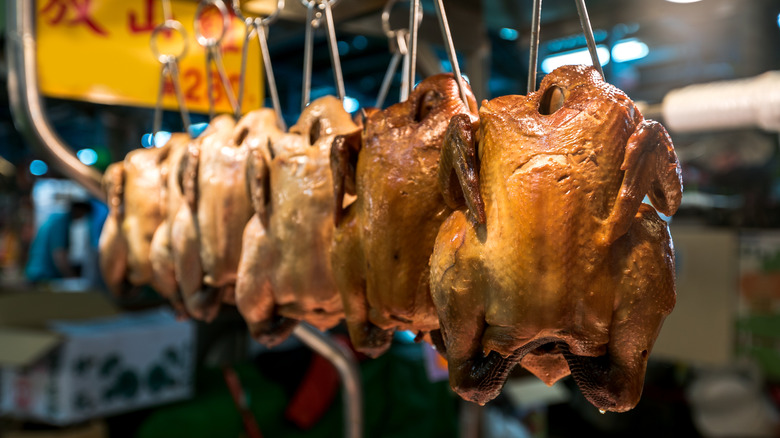The Best Way To Dry Age Chicken With Your Fridge, According To Chef Shola Olunloyo
Some things get better with age — think cheese, wine, your ability to flip an omelet without violating its structural integrity, and certain kinds of protein. When it comes to aging meats like beef and bison, there are two trusty methods that can be effectively used to enhance the taste and texture with minimum chances of spoilage if done properly: wet aging and dry aging. The wet aging technique involves vacuum sealing meat in plastic wrap and letting it sit in the refrigerator for up to three weeks. To dry age meat, you allow it to sit in a temperature-controlled environment with an open airflow and low humidity for weeks or even months.
While dry aging proteins like beef is common practice, one rarely hears of using the same technique to enhance the flavor of poultry like chicken since it is a tender meat as is. Chef Shola Olunloyo might have a hack that can be used for safely dry aging chicken at home for a flavorful bite with that crispy skin that we're all after. During an episode of the Splendid Table podcast, the Studio Kitchen co-founder and chef shared how he uses a fridge in lieu of a dry-aging cabinet for tender proteins like chicken. He spatchcocks it and places it in a sheet pan with a rack. The chicken is then rinsed, dried, seasoned, and placed "in the fridge for three days."
Removing moisture doesn't mean removing juiciness
Speaking with the host of Splendid Table, Shola Olunloyo explained, "When we say 'dry the chicken,' all we're just doing is potentially removing some of the moisture between the skin and the meat and any other surface moisture and it has both a textural and a flavor improvement. It will be more crispy while retaining its juiciness." Spatchcocking the chicken aids air circulation by increasing the surface area, according to the chef.
Other approaches might not be as successful. In an experiment, Guga Foods tried dry aging three chickens in a cabinet for 30 days, two weeks, or three days, respectively, without any seasoning. The birds were also left whole. The first two didn't turn out great. They ended up smelling alarmingly bad. At least one of them didn't appear to dry out entirely. The chicken that was dry-aged for three days seemed edible, but ultimately, the people who would have tested the meat chose not to try any of the chickens. It seems safe to say that the experiment was a failure.
Since chicken can spoil easily, it is necessary to take proper precautions. A general rule of thumb is to not let the raw bird sit out for over two hours. The USDA recommends consuming chicken within one to two days after refrigeration unless frozen at zero degrees F in which case it is safe for consumption for a long time.

